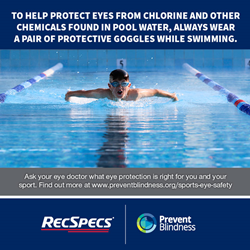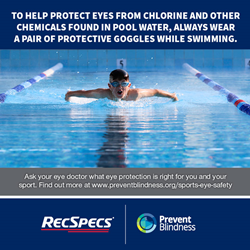
Prevent Blindness declares September as Sports Eye Safety Month to educate the public on the best ways to help protect against eye injuries.
“Although COVID-19 pandemic has considerably limited organized sports over the past year, both professionally and locally, the important thing to remember is the need to protect our eyes from significant and even permanent vision loss,” said Jeff Todd, president and CEO of Prevent Blindness.
CHICAGO (PRWEB)
August 26, 2021
Prevent Blindness, the nation’s oldest non-profit eye health organization, has declared September as Sports Eye Safety Month to help keep eyes and vision protected while playing sports.
According to annual data from Prevent Blindness, more eye injuries occur from pool and water sports than any other category. These injuries may include eye infections and irritations, and scratches or trauma. However, ball sports still account for the highest total injury rate. Injuries may include corneal abrasions, traumatic cataract, detached retina, a fracture of the eye socket and many more sight-threatening occurrences.
The National Eye Institute states that eye injuries are a leading cause of blindness in children in the United States — and most of these injuries happen while kids are playing sports. Wearing the right protective eyewear can prevent 9 out of 10 sports-related eye injuries. Additionally, every 13 minutes an emergency room in the United States treats a sports-related eye injury.
A recent 5-year study found that approximately 20 percent of youth ocular injury visits were sports-related. Although sports such as soccer, baseball, and basketball caused the most eye injuries, shooting sports with paintball and airsoft guns were associated with the greatest loss of vision. Unfortunately, patients infrequently reported the use of protective eyewear at the time of injury.
Prevent Blindness strongly recommends that athletes of any age wear protective eyewear when participating in sports. Prescription glasses, sunglasses and even occupational safety glasses do not provide adequate protection.
Additionally, Prevent Blindness advises the use of protective eye wear that fits securely and comfortably, and allows the use of a helmet, if necessary. Polycarbonate lenses help to provide impact protection. All protective eyewear must meet American Society for Testing Materials (ASTM) standards. An eyecare professional can provide recommendations for the best type of eye protection.
“Although COVID-19 pandemic has considerably limited organized sports over the past year, both professionally and locally, the important thing to remember is the need to protect our eyes from significant and even permanent vision loss,” said Jeff Todd, president and CEO of Prevent Blindness.
Prevent Blindness and Liberty Sport are partnering during September’s Sports Eye Safety Month to promote education and awareness on the ways to protect vision. To download free educational and promotional materials, including the Sports Eye Safety Guide, visit: https://www.libertysport.com/resources or contact Angela Gerber, Liberty Sport, at (973) 882-0986 x972 or agerber@libertysport.com. Social media toolkits are also available by request.
For more information on sports eye injury prevention, please call Prevent Blindness at (800) 331-2020, or visit http://www.preventblindness.org/sports-eye-safety.
About Prevent Blindness
Founded in 1908, Prevent Blindness is the nation’s leading volunteer eye health and safety organization dedicated to fighting blindness and saving sight. Focused on promoting a continuum of vision care, Prevent Blindness touches the lives of millions of people each year through public and professional education, advocacy, certified vision screening and training, community and patient service programs and research. These services are made possible through the generous support of the American public. Together with a network of affiliates, Prevent Blindness is committed to eliminating preventable blindness in America. For more information, visit us at preventblindness.org, and follow us on Facebook, Twitter, Instagram and LinkedIn.
###
Share article on social media or email:

